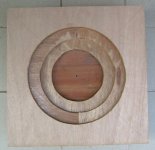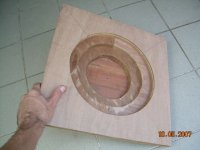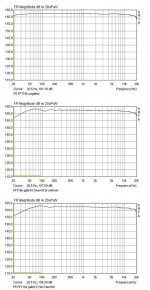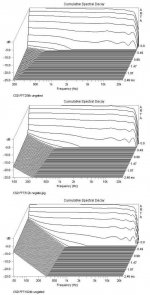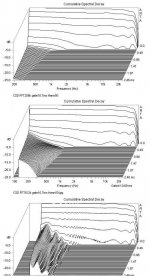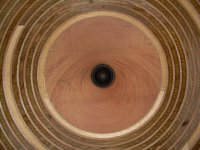Paul W said:panomaniac,
Do you have a link to the kerfed Iwata horns? A quick Google didn't turn up any kerfs.
Unfortunately, no. I have links to the profile he devoloped, but nothing about the slots.
May have to go to back issues of the Revue de l'Audiophile. I'll look into it.
Note that the driver exhibits the same discontinuities that MBK was concerned with.. this time however those discontinuities go further down in freq.. (..MBK - think about that a little further )
2 things came to my mind when I first saw it on my measurements:
1- cone edge reflections and other diaphragm modes
2- baffle induced dips and peaks
Both are highly dependent on measurement setup, especially measurement distance as well. So I for myself wouldn't conclude much from comparing my data with Paul's, too many unknowns.
The Edge: yes, floor reflection is missing, foldback is missing, and when comparing my measurements with simulations using workarounds, I see little similarity. So ut gives you a rough guide, but then, there is reality 😀
Diffraction: it's only >900 Hz or so that the confusion of directional clues through delayed edge diffraction should matter. So that's in tweeter, i.e., monopole/horn territory - so the cancellations from the dipole are not applicable. That's why I think the baffle still matters, and that's why I made mine so wide (amongst other considerations) , to get above 700 us.
Hello,
regarding MBK's waveguide, did you see these products? (I hope I am not repeating something allready posted).
It's intersting that some of them products seems to be MTM with the big weaveguide/short horn in the middle. The distance between drivers is therefore quite big. I wonder how it affects the polar pattern and where is the cross-over point in these conditions.
Zingali
regarding MBK's waveguide, did you see these products? (I hope I am not repeating something allready posted).
It's intersting that some of them products seems to be MTM with the big weaveguide/short horn in the middle. The distance between drivers is therefore quite big. I wonder how it affects the polar pattern and where is the cross-over point in these conditions.
Zingali
Didn't see those - definitely gorgeous! But the horn still looks quite deep in fact, it's just not so apparent because they are flush mounted in box. Separation distance is an issue, depends on the x-o frequency of course.
Raw first horn prototype
Let's call it model 1.4-120- 21n15 v0.1
(1.4" throat, 120 degree coverage, 21" nominal mouth, 15" actual diameter, at the stage of raw glued plywood and lumber prepared for milling).
The cutouts are to cut down on CNC time - the CNC works in extemely fine increments and projected first time estimate for cutting out the horn from a solid block of wood was 17h. For this prototype there are a lot of shortcuts - marine plywood for the mouth sections, and we'll find out if it really is void free later 🙄 , solid 2" thick local construction lumber (a type of mahagony I believe) for the mouth. Rear will not be milled for the prototype, and it's going to be with the roundover only carried out to 90 degrees, to fit a flat baffle cutout, (as in the drawing in previous posts) so it is going to be 15" in actual diameter. If I added the full roundover for a standalone decorative horn it would be 21". But first things first, I first want to know how the off axis response behaves.
Let's call it model 1.4-120- 21n15 v0.1
(1.4" throat, 120 degree coverage, 21" nominal mouth, 15" actual diameter, at the stage of raw glued plywood and lumber prepared for milling).
The cutouts are to cut down on CNC time - the CNC works in extemely fine increments and projected first time estimate for cutting out the horn from a solid block of wood was 17h. For this prototype there are a lot of shortcuts - marine plywood for the mouth sections, and we'll find out if it really is void free later 🙄 , solid 2" thick local construction lumber (a type of mahagony I believe) for the mouth. Rear will not be milled for the prototype, and it's going to be with the roundover only carried out to 90 degrees, to fit a flat baffle cutout, (as in the drawing in previous posts) so it is going to be 15" in actual diameter. If I added the full roundover for a standalone decorative horn it would be 21". But first things first, I first want to know how the off axis response behaves.
Attachments
CSD gating artefacts
In my quest for a CSD protocol that minimizes artefacts and whose resultsI can believe, and while still building a larger test baffle, I had a look at pure gating and computation artefacts. Here I show results from one and the same impulse measurement using various gating and FFT lenghts. So far so good, but to make it DUT-independent I just used a loopback measurement of my soundblaster 24bit soundcard, assuming that the electronics should have negligible decay time wrt speakers.
Using the same impulse data and if gating, always using a 512k gate corresponding to 10.667 ms, the other variables were:
- window: Uniform or 50% Hann
- FFT length of the CSD: 256, 512 or 1024 (the largest possible allowed for 512k gates impulse data).
Here are the results for pure FR obtained with various gating methods. One can clearly see the leakage (as far as I understand how FFT combines with gating) that wrecks the FR if a short gate is used with a uniform window. The FR with 50% Hann window is much closer to the ungated one. Even then though a bump around 100 Hz appears.
In my quest for a CSD protocol that minimizes artefacts and whose resultsI can believe, and while still building a larger test baffle, I had a look at pure gating and computation artefacts. Here I show results from one and the same impulse measurement using various gating and FFT lenghts. So far so good, but to make it DUT-independent I just used a loopback measurement of my soundblaster 24bit soundcard, assuming that the electronics should have negligible decay time wrt speakers.
Using the same impulse data and if gating, always using a 512k gate corresponding to 10.667 ms, the other variables were:
- window: Uniform or 50% Hann
- FFT length of the CSD: 256, 512 or 1024 (the largest possible allowed for 512k gates impulse data).
Here are the results for pure FR obtained with various gating methods. One can clearly see the leakage (as far as I understand how FFT combines with gating) that wrecks the FR if a short gate is used with a uniform window. The FR with 50% Hann window is much closer to the ungated one. Even then though a bump around 100 Hz appears.
Attachments
Now for a CSD from ungated data. All is fine except that when increasing the resolution from 256 to 512 and 1024k a monotonic LF tail appears. I somehow already suspected this to happen given the family resemblance of all our LF data with tails, in a frequency region where woofers should have no major problems to control themselves 😀
Attachments
Now for the shocker, the grand finale. A typical 10 ms-ish gate, combined with increasing FFT resolution (256, 512, 1024). All other parameters in the CSD were left at Arta's default, which is 60 slices at 2 samples shift, with 0.2 ms window rise times.
Clearly, we see those familiar ripples, waves, ridges and canyons in the LF regions appear, as high up as 500 Hz, pretending to show severe energy storage / resonance / ripples.
The only really clean graph is the 256 FFT, half as many samples as data in the gated length. WHile Arta will allow you to set the CSD's FFT resolution to up to 2x the gated sample length, using this allowance clearly is not advised.
Conclusion, if gating is used, use appropriate windows for FR, and be very conservative with your CSD FFT length. The more samples the merrier. At the very least use FFT samples <= gate samples.
And, don't believe the low end decay tail.
Clearly, we see those familiar ripples, waves, ridges and canyons in the LF regions appear, as high up as 500 Hz, pretending to show severe energy storage / resonance / ripples.
The only really clean graph is the 256 FFT, half as many samples as data in the gated length. WHile Arta will allow you to set the CSD's FFT resolution to up to 2x the gated sample length, using this allowance clearly is not advised.
Conclusion, if gating is used, use appropriate windows for FR, and be very conservative with your CSD FFT length. The more samples the merrier. At the very least use FFT samples <= gate samples.
And, don't believe the low end decay tail.
Attachments
Hi
MBL, revealing pictures!
Even better leakage and FR behaviour would be obtained with other windows like described here.
http://www.lds-group.com/docs/site_documents/AN014 Understanding FFT Windows.pdf
" http://www.lds-group.com/docs/site_documents/AN014 Understanding FFT Windows.pdf "
Unfortunately ARTA is not providing such a wide variety for gating.
With the "AudioTester" software the "Rife and Vincent" window is my personal favourite for FR measurement, giving great leakage suppression. Unfortunately CSD does not work really good in AudioTester.
Greetings
Michael
MBL, revealing pictures!
Even better leakage and FR behaviour would be obtained with other windows like described here.
http://www.lds-group.com/docs/site_documents/AN014 Understanding FFT Windows.pdf
" http://www.lds-group.com/docs/site_documents/AN014 Understanding FFT Windows.pdf "
Unfortunately ARTA is not providing such a wide variety for gating.
With the "AudioTester" software the "Rife and Vincent" window is my personal favourite for FR measurement, giving great leakage suppression. Unfortunately CSD does not work really good in AudioTester.
Greetings
Michael
Hi Michael,
thanks for the link, yes, windowing is tricky... but other things as well! Today I was trying to reproduce the effects I measured yesterday, but I only got clean CSD's from the loopback measurement. Further probing and retracing my steps revealed that it's more vicious than assumed, but it's not the windowing alone that's to blame.
Yesterday I made an initial measurement where the FR was oddly shaped. I had forgotten to switch off the Soundblaster card's EQ. So I turned it off and the FR became flat, as it should. I then made many trials, before I recorded the graphs I showed, and they all showed variations of these artefacts. Then I turned the PC off, leaving the EQ off. Today I turned it on with the EQ already off - and could not replicate any artefacts.
Sooo.... turns out that the Soundblaster EQ somehow stayed in residence even when off, *if* the PC was started with the EQ *on* - but not if started with the EQ *off*. I conclude that the CSD tails in the LF were due to a resampling / delay related to the soundcard software. Which neatly translates into yet another possible error mechanism 🙄 Not to mention it shows graphically how badly the resampling or whatever it is, is really capable of affecting the sound.
Still, gating and windowing are just as tricky issues, I'll have to explore that further.
thanks for the link, yes, windowing is tricky... but other things as well! Today I was trying to reproduce the effects I measured yesterday, but I only got clean CSD's from the loopback measurement. Further probing and retracing my steps revealed that it's more vicious than assumed, but it's not the windowing alone that's to blame.
Yesterday I made an initial measurement where the FR was oddly shaped. I had forgotten to switch off the Soundblaster card's EQ. So I turned it off and the FR became flat, as it should. I then made many trials, before I recorded the graphs I showed, and they all showed variations of these artefacts. Then I turned the PC off, leaving the EQ off. Today I turned it on with the EQ already off - and could not replicate any artefacts.
Sooo.... turns out that the Soundblaster EQ somehow stayed in residence even when off, *if* the PC was started with the EQ *on* - but not if started with the EQ *off*. I conclude that the CSD tails in the LF were due to a resampling / delay related to the soundcard software. Which neatly translates into yet another possible error mechanism 🙄 Not to mention it shows graphically how badly the resampling or whatever it is, is really capable of affecting the sound.
Still, gating and windowing are just as tricky issues, I'll have to explore that further.
FWIW I just found this post in another thread. It references a project with 15ND930 crossed to a horn with 2" driver, at 1.1k. It looks like a prosound/club application, but the measurements and CSD they show sure look like the 15" can go that high w/o any trouble. Interesting also that they didn't go lower with the x-o even though the 2 incher is surely capable of going down to 800 Hz at least.
Anyway I am already working on a large test baffle so I can get better CSD's myself.
Anyway I am already working on a large test baffle so I can get better CSD's myself.
What a great thread! I just found this for the first time and read through it all last night.
I am planning to do a very similar project. Currently I have a pair of JBL 2123H 10" mids and a pair of DDS eng 1-90 wg's, but I don't know if I'll use them or not. My intention is to build an OB speaker, not so different from Paul's or Lynn's ideas. I was thinking of the Ciare 18ndw1 for woofer duties and sub for first octave.
I pretty much thought I was going to try the BMS 4552ND but now I am a bit curious about the Radian 850pb's. I am just lost for a suitable horn.
Scott, I know you mentioned the DDS 110 or 100, for 2" they only show the 110 which doesn't look to have a smooth profile, the 100 did but didn't come in 2". I am just worried about HOM and typical horn honkiness. I have heard Geddes' Summas (at his house) and they had none of that, so I know his theory is sound. But my experience in this realm is near neglible, so the only thing I have to rely on is my limited experience and the guidance of those who have tried.
Should I be worried about HOMs on non-symmetric horns/wg's? Also, my biggest concern is not from ceiling/floor bounce as my room has 12' ceilings and I sit 9' back from my mains and I have a thick wool rug between. My concern is great sound without any bite, resonance or other nasties.
Is there any other horns out there to consider? I saw woodhorns.com makes a profile that looks like the DDS 1-100 for 2" CD's but $2200 is quite a bit more than I am willing to spend without knowing what I am getting into.
I am also not 100% sure I followed the rationale for why you wanted directivity from the mid going low. Is that so it matched the forward response of the dipole woofer at xo? Now, that I say that outloud, it makes sense. I guess the other option is the U-baffle (with care to treat resonance) for the woofer and wider response for the mid.
Great thread, keep it going!
I am planning to do a very similar project. Currently I have a pair of JBL 2123H 10" mids and a pair of DDS eng 1-90 wg's, but I don't know if I'll use them or not. My intention is to build an OB speaker, not so different from Paul's or Lynn's ideas. I was thinking of the Ciare 18ndw1 for woofer duties and sub for first octave.
I pretty much thought I was going to try the BMS 4552ND but now I am a bit curious about the Radian 850pb's. I am just lost for a suitable horn.
Scott, I know you mentioned the DDS 110 or 100, for 2" they only show the 110 which doesn't look to have a smooth profile, the 100 did but didn't come in 2". I am just worried about HOM and typical horn honkiness. I have heard Geddes' Summas (at his house) and they had none of that, so I know his theory is sound. But my experience in this realm is near neglible, so the only thing I have to rely on is my limited experience and the guidance of those who have tried.
Should I be worried about HOMs on non-symmetric horns/wg's? Also, my biggest concern is not from ceiling/floor bounce as my room has 12' ceilings and I sit 9' back from my mains and I have a thick wool rug between. My concern is great sound without any bite, resonance or other nasties.
Is there any other horns out there to consider? I saw woodhorns.com makes a profile that looks like the DDS 1-100 for 2" CD's but $2200 is quite a bit more than I am willing to spend without knowing what I am getting into.
I am also not 100% sure I followed the rationale for why you wanted directivity from the mid going low. Is that so it matched the forward response of the dipole woofer at xo? Now, that I say that outloud, it makes sense. I guess the other option is the U-baffle (with care to treat resonance) for the woofer and wider response for the mid.
Great thread, keep it going!
JoshK said:
Scott, I know you mentioned the DDS 110 or 100, for 2" they only show the 110 which doesn't look to have a smooth profile, the 100 did but didn't come in 2". I am just worried about HOM and typical horn honkiness. I have heard Geddes' Summas (at his house) and they had none of that, so I know his theory is sound. But my experience in this realm is near neglible, so the only thing I have to rely on is my limited experience and the guidance of those who have tried.
Should I be worried about HOMs on non-symmetric horns/wg's? Also, my biggest concern is not from ceiling/floor bounce as my room has 12' ceilings and I sit 9' back from my mains and I have a thick wool rug between. My concern is great sound without any bite, resonance or other nasties.
Is there any other horns out there to consider? I saw woodhorns.com makes a profile that looks like the DDS 1-100 for 2" CD's but $2200 is quite a bit more than I am willing to spend without knowing what I am getting into.
I am also not 100% sure I followed the rationale for why you wanted directivity from the mid going low. Is that so it matched the forward response of the dipole woofer at xo? Now, that I say that outloud, it makes sense. I guess the other option is the U-baffle (with care to treat resonance) for the woofer and wider response for the mid.
Great thread, keep it going!
Ha! DDS's website is finally back up.
http://www.ddshorns.com/catalog.php?page=CFD2110Pro
Yes - the 110. (I was going by my memory - which is *quite* faulty 😀 )
Earl can a-fix the moniker "HOM's" to the problem - but it is edge diffraction (..though horn instead of baffle). Essentially a high pressure zone meeting a low pressure zone creating air turbulence (..not unlike a storm front, where lightning and the resulting thunder is the major "diffraction" artifact). Of course with a horn (and any convex cone profile), the spl artifacts from edge diffraction will "travel" and interact with the horn/cone negatively and slightly delayed in time relative to the overall output.
The real question(s) then is - whats the sp-level of edge diffraction artifacts relative to the overall output? Also, whats the freq. relative to its level? Finally, whats the freq. of the dominate phase "null" AND how "broad" in bandwidth is that null?
The above questions are to suggest that with a *good* horn you can mostly circumvent those problems with proper attenuation.
Determining a "good" horn, AND determining where such a horn should be attenuated, is largely a matter of polar response.
Looking at the CFD 2-110 Pro's HORIZONTAL polar response we see some deviation from its dominate polar character. Moving left and right from the 0 degree axis the first two lines we come to are substantially deviated from the group. These two lines represent the very highest freq.s of this horn. Further "out" from there we come across two other lines that are also more deviated than the group average - these two lines represent the lowest freq.s of the horn. These deviations are where the horn's pattern control starts to become compromised. The high freq. result in "beaming". The lowest freq.s (with regard to sp-levels) only become a consideration with their interaction to the next driver (..typically a midbass dynamic coil). Note though that the lowest freq.s of the horn ARE a concern with regard to the dominate phase null and its character.
So then - the horizontal polar character is reasonably uniform from about 10.5 kHz down to around 1.05 kHz. Moreover, from 1.05 kHz to 630 Hz it isn't "bad" either - the main concern being spl-matching with the midbass driver. (..in fact greater directivity at lower freq.s can be a good thing, just make sure that the sp-level transition between drivers is not "abrupt" for anymore than about a 3 db deviation.)
Now lets look at the vertical character.
Obviously it doesn't pretend to be a CD design vertically - here pattern coverage decreases as freq.s increase (..which is fairly normal). Now YOU (or some other listener) could have a problem with such a design, *even* if you listen directly on-axis. Basically you have a 30 degree coverage angle, (+/- 15 degrees from the 0 degree axis) without suffering too much high freq. attenuation. A typical "remedy" for this is to directionally aim the horn so that the listener is within this coverage angle. (i.e. if its up high - then aim downward to the listener.. if down low, then aim up to the listener, otherwise make sure the height of the horn is near the listener's ear level.)
That "does it" for *most* people, BUT you may be one of those that is bothered by a narrow vertical response. All I can say here is try it for yourself to see. I can add however that it is NOT the same as narrow directivity achieved through polar "combing" (i.e. two drivers operating in the same passband at the same level with significant distance between them). I personally have a problem with that, but do not with a vertically narrow waveguide.
Anyway..
Finally we want to look at Earl's "HOM's"..
Now the dominant "null" of the horn's edge diffraction is predominantly NOT seen in the polar response graphs for this driver because it isn't represented do to its limited freq. response - i.e. 630 Hz as opposed to near (and below) 500 Hz. Note however that edge diffraction does have a trailing response that extends much higher in freq. (and also a little lower as well). Here though, we don't see too much alteration in freq. response (often ripples), but it could be that its simply "averaged-out".
The next thing to look at then is the shape of the horn flare itself..
The shape of this horn is rather low in expansion *horizontally*, with little "edge" profile (i.e the angle from horn mouth exit to baffle connection is low). This means that horizontally we shouldn't have to many problems.
Vertically however the edge angle is moderately "sharp".. all else equal you would expect to have greater problems here. Now that might not be the case because the overall edge diffraction is combination of edge sources (i.e. vertical AND horizontal in this case). Still - if it was a problem, then it could be reduced by adding a round-over "lip" profile to the horn.
So then IS it a problem here? I don't know, but I'm guessing that IF you attenuate the level near the problem sufficiently then it shouldn't be objectionable. As to what "sufficient" is - thats a listener thing. My cautionary "guide" is a minimum of -9db below the average for the dominate artifact.
Of course NONE of the above goes into horn expansion vs. compression and directivity and why its preferable to have horn with less overall compression. The CFD 2-110 Pro however, achieves lower compression and wider horizontal dispersion vs. other offerings without to many compromises - provided its used correctly.
There are of course alternatives - but those alternatives typically either decrease directivity (smaller horns), OR increase compression (even more narrow throat bi-radials), AND/OR decrease driver size for a given horn and increasing freq. ripple. There are however several horns out there that might be better, but are not measured - so you don't really have an idea. Here is a fairly decent listing of horns (though at slightly higher prices than you can find else where):
http://www.usspeaker.com/homepage.htm
Scott,
Thanks for the informative and detail response! That is why these forums are so great. It would take forever to learn all this on your own from books and experience.
Josh
Thanks for the informative and detail response! That is why these forums are so great. It would take forever to learn all this on your own from books and experience.
Josh
The throat area is solid wood to make sure it is smooth and without gaps or cracks. The driver put for demo her in the picture is a Vifa D27TG-35-06 which I will use to test polar response and FR for the time being. Although an 1" dome nominally, the actual face plate opening is almost precisely 1.4" (a bit larger in fact).
Attachments
Member
Joined 2003
Waveguides are looking good! I used that same Vifa tweeter for some early tests in the MSC WG with good results. Some of the newer soft domes did not do as well as the old Vifa...my guess is the newer design domes were deforming when playing into a restricted space. You'll often see a narrow response "notch" in the 10-15k range with soft domes in a WG, but I'm guessing/hoping you won't have a problem with the Vifa in a fast-opening flare.
Thanks... I am varnishing the prototype now, to get rid of end grain roughness of the plywood and for protection in this climate here.
I had the Vifa in surplus, and Zaph also had his better results with soft domes I believe. I'll also compare with vs. without faceplate because in a WG the faceplate does not really serve a purpose anymore and the fit is actually better without. I have Seas 27TBFCG as well to try out (in my mains) though these didn't fare so well in tests by others IIRC, and taking off the faceplate would also rob it of the phase shield (which is actually just a clear plastic sticker inside the metal grid).
Anyway, that's some material for testing already. Will have to wait for next week though, no time the next few days.
I had the Vifa in surplus, and Zaph also had his better results with soft domes I believe. I'll also compare with vs. without faceplate because in a WG the faceplate does not really serve a purpose anymore and the fit is actually better without. I have Seas 27TBFCG as well to try out (in my mains) though these didn't fare so well in tests by others IIRC, and taking off the faceplate would also rob it of the phase shield (which is actually just a clear plastic sticker inside the metal grid).
Anyway, that's some material for testing already. Will have to wait for next week though, no time the next few days.
- Status
- Not open for further replies.
- Home
- Loudspeakers
- Multi-Way
- Large midrange for OB??? Scott G ?
